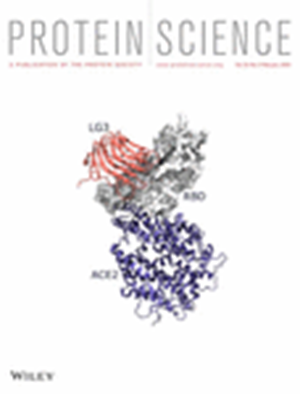血清淀粉样蛋白 A 八聚体的结构研究,该八聚体可作为脂质纳米盘的支架
IF 4.5
3区 生物学
Q1 BIOCHEMISTRY & MOLECULAR BIOLOGY
引用次数: 0
摘要
血清淀粉样蛋白 A(SAA)是一种高度保守的急性期蛋白,在急性炎症反应期间可激活多种促炎症途径,通常被用作炎症的生物标志物。它通过改善损伤部位脂质和胆固醇的清除,在组织修复中发挥有益作用。在慢性炎症性疾病患者中,SAA 水平的升高可能会加重潜在疾病的严重程度。循环中的 SAA 大部分与脂蛋白结合,主要是高密度脂蛋白(HDL)。与 HDL 的相互作用不仅能稳定 SAA,还能改变其功能特性,这可能是通过改变 SAA 上蛋白质与蛋白质相互作用位点的可及性实现的。虽然无脂或脂蛋白形式 SAA 的高分辨率结构已有报道,但它们与高密度脂蛋白结合形式的蛋白质以及 SAA 与脂质结合的其他可能机制之间的关系尚未确定。在这里,我们使用了多种生物物理技术,包括 SAXS、TEM、SEC-MALS、原生凝胶电泳、戊二醛交联和胰蛋白酶消化,来描述 SAA 的无脂和脂质结合形式。SAXS和TEM数据显示,SAA存在可溶性八聚体,其结构与已报道的无脂载脂蛋白A-I的环状结构相似。这些 SAA 八聚体代表了无脂 SAA 以前未曾表征的结构,能够构建与载脂蛋白 ApoA-I 形成的形态相似的脂质纳米盘。SAA-脂质纳米圆片含有四个 SAA 分子,其外部尺寸与无脂 SAA 八聚体相似,这表明 SAA 与 HDL 等含脂微粒的相互作用可能只需要相对较少的构象重排。这项研究为 SAA 与脂质的相互作用提出了一个新的模型,并为了解 SAA 如何在炎症期间稳定蛋白-脂质纳米盘,甚至取代载脂蛋白 ApoA-I 成为 HDL 颗粒的支架提供了新的见解。本文章由计算机程序翻译,如有差异,请以英文原文为准。
Structural studies of a serum amyloid A octamer that is primed to scaffold lipid nanodiscs
Serum amyloid A (SAA) is a highly conserved acute‐phase protein that plays roles in activating multiple pro‐inflammatory pathways during the acute inflammatory response and is commonly used as a biomarker of inflammation. It has been linked to beneficial roles in tissue repair through improved clearance of lipids and cholesterol from sites of damage. In patients with chronic inflammatory diseases, elevated levels of SAA may contribute to increased severity of the underlying condition. The majority of circulating SAA is bound to lipoproteins, primarily high‐density lipoprotein (HDL). Interaction with HDL not only stabilizes SAA but also alters its functional properties, likely through altered accessibility of protein–protein interaction sites on SAA. While high‐resolution structures for lipid‐free, or apo‐, forms of SAA have been reported, their relationship with the HDL‐bound form of the protein, and with other possible mechanisms of SAA binding to lipids, has not been established. Here, we have used multiple biophysical techniques, including SAXS, TEM, SEC‐MALS, native gel electrophoresis, glutaraldehyde crosslinking, and trypsin digestion to characterize the lipid‐free and lipid‐bound forms of SAA. The SAXS and TEM data show the presence of soluble octamers of SAA with structural similarity to the ring‐like structures reported for lipid‐free ApoA‐I. These SAA octamers represent a previously uncharacterized structure for lipid‐free SAA and are capable of scaffolding lipid nanodiscs with similar morphology to those formed by ApoA‐I. The SAA–lipid nanodiscs contain four SAA molecules and have similar exterior dimensions as the lipid‐free SAA octamer, suggesting that relatively few conformational rearrangements may be required to allow SAA interactions with lipid‐containing particles such as HDL. This study suggests a new model for SAA–lipid interactions and provides new insight into how SAA might stabilize protein‐lipid nanodiscs or even replace ApoA‐I as a scaffold for HDL particles during inflammation.
求助全文
通过发布文献求助,成功后即可免费获取论文全文。
去求助
来源期刊

Protein Science
生物-生化与分子生物学
CiteScore
12.40
自引率
1.20%
发文量
246
审稿时长
1 months
期刊介绍:
Protein Science, the flagship journal of The Protein Society, is a publication that focuses on advancing fundamental knowledge in the field of protein molecules. The journal welcomes original reports and review articles that contribute to our understanding of protein function, structure, folding, design, and evolution.
Additionally, Protein Science encourages papers that explore the applications of protein science in various areas such as therapeutics, protein-based biomaterials, bionanotechnology, synthetic biology, and bioelectronics.
The journal accepts manuscript submissions in any suitable format for review, with the requirement of converting the manuscript to journal-style format only upon acceptance for publication.
Protein Science is indexed and abstracted in numerous databases, including the Agricultural & Environmental Science Database (ProQuest), Biological Science Database (ProQuest), CAS: Chemical Abstracts Service (ACS), Embase (Elsevier), Health & Medical Collection (ProQuest), Health Research Premium Collection (ProQuest), Materials Science & Engineering Database (ProQuest), MEDLINE/PubMed (NLM), Natural Science Collection (ProQuest), and SciTech Premium Collection (ProQuest).
 求助内容:
求助内容: 应助结果提醒方式:
应助结果提醒方式:


